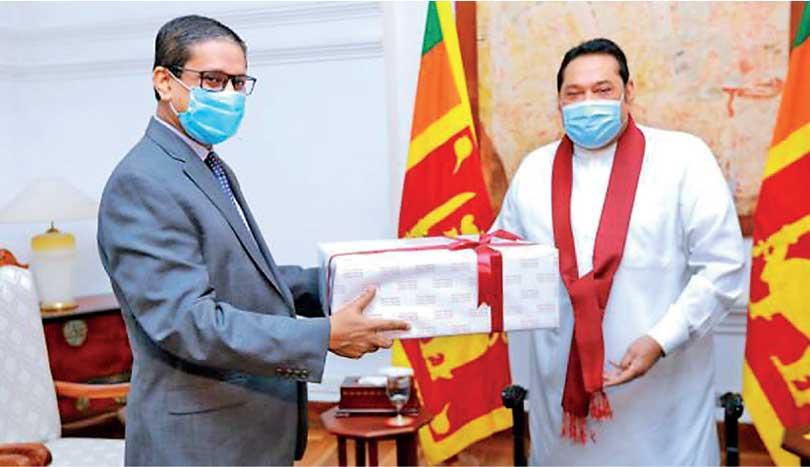Reply To:
Name - Reply Comment
 Bangladesh High Commissioner Riaz Hamidullah with Sri Lankan Prime Minister Mahinda Rajapaksa
Bangladesh High Commissioner Riaz Hamidullah with Sri Lankan Prime Minister Mahinda Rajapaksa
 The lockdowns and barriers imposed in countries across the globe following the outbreak of COVID-19 have crippled economies. But COVID or no COVID, countries are now constrained to open up to give back to the people their livelihoods. Therefore, it is time governments geared themselves up to meet the challenges of the post-COVID-19 world.
The lockdowns and barriers imposed in countries across the globe following the outbreak of COVID-19 have crippled economies. But COVID or no COVID, countries are now constrained to open up to give back to the people their livelihoods. Therefore, it is time governments geared themselves up to meet the challenges of the post-COVID-19 world.
The disruptions brought about by COVID-19 call for fresh thinking on many things hitherto taken for granted. Since Sri Lanka and Bangladesh face similar problems, their approaches and solutions to post-COVID-19 issues could be similar.
Like Sri Lanka, Bangladesh has been heavily dependent on the apparel industry and overseas workers’ remittances. Again, like Sri Lanka, Bangladesh has been heavily dependent on Western markets. The apparel industry in both countries is suffering for want of orders from the West due to the disruption of the latter’s economies by COVID-19. Both Sri Lanka and Bangladesh have similar institutional and infrastructural drawbacks. An inability to rein in corruption is one of them.
 Bangladeshi diplomat, Mustafizur Rahman, in his June 9 paper entitled: Global Partnership: Crucial to Bangladesh’s Economy and Development Strengthened Goals written for the National University of Singapore, points out that the Ready Made Garments (RMG) sector, which accounted for 12% of the GDP and 84% of total exports, is in shambles now with US$ 3 billion worth of orders cancelled. This has directly affected two million garment workers, mostly women. Remittances, which are the second-largest driver of the Bangladesh economy, could go down by 20%. In 2019,US$ 18 billion was brought into the country by over 10 million Bangladeshis working overseas, mostly in the Middle East. But Middle East economies have been hit hard by declining oil prices. Private investment and FDIs in Bangladesh are also expected to drop, particularly affecting 50 million workers in the informal sector.
Bangladeshi diplomat, Mustafizur Rahman, in his June 9 paper entitled: Global Partnership: Crucial to Bangladesh’s Economy and Development Strengthened Goals written for the National University of Singapore, points out that the Ready Made Garments (RMG) sector, which accounted for 12% of the GDP and 84% of total exports, is in shambles now with US$ 3 billion worth of orders cancelled. This has directly affected two million garment workers, mostly women. Remittances, which are the second-largest driver of the Bangladesh economy, could go down by 20%. In 2019,US$ 18 billion was brought into the country by over 10 million Bangladeshis working overseas, mostly in the Middle East. But Middle East economies have been hit hard by declining oil prices. Private investment and FDIs in Bangladesh are also expected to drop, particularly affecting 50 million workers in the informal sector.
The Bangladesh government needs an additional US$ 928.48 billion to achieve the Sustainable Development Goals (SDG) by 2030. The World Bank has fast-tracked US$ 100 million to support Bangladesh’s fight against the virus. But this is chicken feed. On its part, the Bangladesh government has announced rescue packages totally valued at US$ 11.9 billion, which is equivalent to 3.6% of the country’s GDP, Rahman said.
Even before COVID-19, Khaled Chowdhury had written in The Daily Star in 2018 that Bangladesh could diversify its production and export baskets by making forays into less technological-intensive products such as paper goods, mobile phone accessories, umbrellas, basic lighting, tiles, etc. The earning potential from exporting these products could be significant he said, pointing out that China was the major exporting country for these and many other basic products.
Bangladeshi entrepreneurs need to make Continuous Business Process Improvement (BPI) an integral part of their growth strategies, Chowdhury said. In the 1980s, the US automotive industry lost its top position to Japanese automakers when the Japanese adopted Continuous Business Process Improvement (Kaizen) to cut down inefficiencies and wastage of material and time, he pointed out.
Some Sri Lankan products have great potential in the Bangladeshi market. For example, a popular brand of Sri Lankan hair oil has displaced an Indian product. Sri Lankan investors in Bangladesh should not look only at the Bangladesh middle class market which is about 30 million
Corruption is the other major issue in both Bangladesh and Sri Lanka. A 2014 paper presented by the US-based Milken Institute quoted the World Bank as saying the Bangladesh government was losing more than US$500 million a year due to corruption. And poor management practices cost US$ 1 billion. Bangladesh established a Board of Investment in 1989. But the BOI was not adequately empowered and therefore has had trouble attracting significant foreign private capital, other than in certain industries. For investments to come, whether from within the country or without, doing business must be made easier. But as per the World Bank’s Ease of Doing Business ranking, Bangladesh was poorly placed, the Milken Institute report said.
Planning for a set period of time is also essential, as the experience of South Korea shows. The Milken Institute’s report says: “In 1961, South Korea’s military government established the Economic Planning Board, which produced a series of five-year plans for economic development from 1967 to 1981. These plans offered firms a number of incentives, such as tax benefits and low-interest bank loans to increase and diversify exports. Further, the government reduced or eliminated all taxes and import restrictions placed on intermediary goods used in export production. Existing industries, including textiles, clothing, and electrical machinery, benefited from the lifted import restrictions. Exports increased. Later, under the third five-year plan, investment in machinery, steel, shipbuilding increased. The result was a dramatic change in the character of South Korean exports: from commodities and processed foods in the 1960s (75% of South Korea’s exports in 1962) to manufactured goods (almost 90% of exports in 1985) and high-tech products since the 1990s. Today, heavy industry—including semiconductors, telecom equipment, automobiles, computers, steel, ships, and petrochemicals—accounts for 90% of all exports.”
Bangladesh’s advantages
However, there is a crucial difference between Sri Lanka and Bangladesh. Prior to COVID, unlike Sri Lanka, Bangladesh was already well on the way to becoming a “South Asian Tiger.” From 2009 till this year, Bangladesh’s GDP was growing at 7% per annum and its per capita income had doubled from US$ 860 to the US$ 1,751.
Bangladesh has also been enjoying political stability with a purposeful government. Sheikh Hasina’s Awami League has been firmly entrenched in power. The opposition Bangladesh Nationalist Party has discredited itself and is in limbo. An unfettered Sheikh Hasina put down the highly disruptive Islamic extremists with an iron hand. When the Bangladesh Prime Minister lays down the law, her writ runs. In other words Sheikh Hasina is eminently in a position to turn the economy round and put it on a new trajectory. She had already turned Bangladesh, the infamous “basket case” into a potential “South Asian Tiger” before COVID-19 struck. All she has to do is to pick up the threads.
Bangladesh envoy in Sri Lanka Riaz Hamidullah did not agree with the view that doing businessmen in Bangladesh is difficult. He quoted the Chairman of one of the Sri Lankan power and gas company W.K.H.Wegapitiya, as saying that he had invested in Bangladesh because of the “comfort” factor. Wegapitiya had told a seminar in Colombo in 2018 that Bangladeshi officials would go out of their way to iron out issues or remove any obstacles that might arise. U. Gamini Sarath, General Manager of an Offshore Operations of Group, which has invested in power generation, had said he would walk into the offices of the top functionaries in Bangladesh departments without a prior appointment, and get his work done. High Commissioner Riaz Hamidullah said that Bangladeshis are welcoming by nature and are not suspicious about foreign investors. He pointed out that many Sri Lankans work in the garment and other sectors in Bangladesh in high capacities and send back to Sri Lanka US$ 2 million per year as remittance.
Some Sri Lankan products have great potential in the Bangladeshi market. For example, a popular brand of Sri Lankan hair oil has displaced an Indian product, he said, but added that Sri Lankan investors in Bangladesh should not look only at the Bangladesh middle class market which is about 30 million. “They should look at the larger Indian market next door.”
As for Bangladeshi investments in Sri Lanka, Hamidullah said that protectionism was a major barrier. “It stunts growth by shutting off opportunities,” he commented.
However, there are areas of cooperation which should be explored. Listing them, Hamidullah said: “Bangladesh would profit from Sri Lankan expertise in hospitality, hotel management, and accountancy. And Sri Lanka could benefit from Bangladesh’s experience in rice cultivation in various climatic and soil conditions; inland fisheries, disaster management and coastal shipping.”